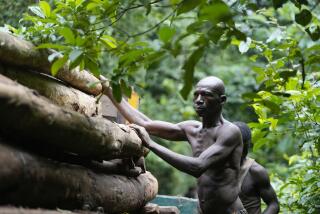Go Slowly or Risk Missing Forest
- Share via
FINGER LAKES NATIONAL FOREST, N.Y. — All the rangers in this Lilliputian national forest got together for a meeting on a recent fall day.
All three of them.
They laughed about the stranger from California who drove through the forest and almost missed it.
“People from the West cannot imagine a national forest this small,” said ranger Nancy Coy, 42.
The tiny Finger Lakes National Forest, with 13,232 acres of rolling hills, meadows and woods, is only 3 miles wide and 12 miles long.
That’s a speck on the map compared to Angeles National Forest in Los Angeles County, which is 50 times bigger. In California, one-fifth of all the state’s land is national forest. California has 17 national forests with 1,500 times more land in national forests than the state of New York.
The newest of America’s 156 national forests, Finger Lakes is perched on a ridge between Seneca and Cayuga Lakes in west central New York. Created by Congress in 1985, it is the only national forest in New York.
“Despite our small size, we offer a full program of activities, the same range as the bigger national forests,” said ranger Mark Welch, 39.
With 28 miles of trails, activities include hiking and horseback riding in the summer, and cross-country skiing, snowmobiling and snowshoeing in the winter. There are three regular campgrounds with a special back-country campground for horseback riders and campfire programs for everybody.
There is hunting for rabbit, grouse, pheasant and whitetail deer, and fishing in the small wildlife ponds.
Visitors to the forest can pick blueberries, raspberries and apples.
In the spring, bird-watchers come from all over the East to see the wide variety of birds. In fall, the forest is emblazoned in a dazzling rainbow of colors. In winter, it lies under a peaceful blanket of snow.
The forest is in the heart of New York’s Finger Lake country. The 11 long, narrow, glacial, parallel lakes extending north to south are: Seneca, Cayuga, Skaneateles, Owasco, Keuka, Canandaigua, Conesus, Hemlock, Canadice, Honeoye and Otisco.
According to Indian legend, the lakes were formed when God placed his handprint on some of the most beautiful country in the world.
Finger Lakes National Forest is a patchwork quilt of some 135 former farms. During the Great Depression, when farmers here fell on hard times, the federal government bought the marginal farmland so its owners could relocate in more productive areas.
The land was purchased between 1933 and 1941. The farmers were paid $8 to $10 an acre. Most of them moved their homes, barns and other structures on horse-drawn wagons and started life anew elsewhere.
Landmarks in the forest are a legacy of the farming period. The highest point in the forest is Chicken Coop Peak. Other local names include Teeter Pond, Breakneck Creek, Cat Elbow Corner, Burned Hill and Hector’s Backbone.
At first, the U.S. Soil Conservation Service administered the former farmland. In the late 1950s, however, the land was turned over to the U.S. Forest Service and placed under a “land use” category managed by the Green Mountain National Forest headquartered in Rutland, Vt., some 300 miles to the north.
In 1982, the Reagan Administration proposed the area be sold to the private sector with the proceeds going to help reduce the national debt.
“Local people rose up and struck back. They launched a ‘Save Our Forest’ campaign and succeeded in convincing Congress it should be made into a national forest,” recalled chief ranger Joel Fiske, 35.
The national forest still looks a lot like farmland because the Forest Service leases one-third of the land for grazing.
This year, 60 people grazed 1,200 head of cattle--half dairy, half beef--paying $2.39 a head per month. Some grazed only one animal. One farmer grazed 200. The fees netted the government $16,000.
Timber sales are also conducted in the forest. This year, the government received $40,000 for oak, maple and ash trees cut by timber companies. Half the national forest is in timber land.
As the National Forest’s only employees, the three rangers do it all. They manage the leasing of the land to livestock growers and handle the timber sales. They run the campfire programs and lead trail hikes. They maintain the trails, manage wildlife ponds, and put up nest boxes for birds and small mammals. They operate the campgrounds and deal with the public.
“We get a lot of help from volunteers. Local hiking clubs help maintain trails. We have no fire equipment. If there’s a fire in the forest, we rely on volunteer fire departments in neighboring villages,” said Fiske.
But fires, like everything else here, are minimal compared to typical forest fires in the West, which often devastate huge stands of timber. The biggest fire in the history of Finger Lakes National Forest was less than five acres--in keeping, one might say, with its Lilliputian ways.
“Rangers from forests all across America drop in and visit us from time to time to see how we operate because we’re so small,” said ranger Coy, who added:
“Being small is special. We like it.”
More to Read
Sign up for The Wild
We’ll help you find the best places to hike, bike and run, as well as the perfect silent spots for meditation and yoga.
You may occasionally receive promotional content from the Los Angeles Times.





